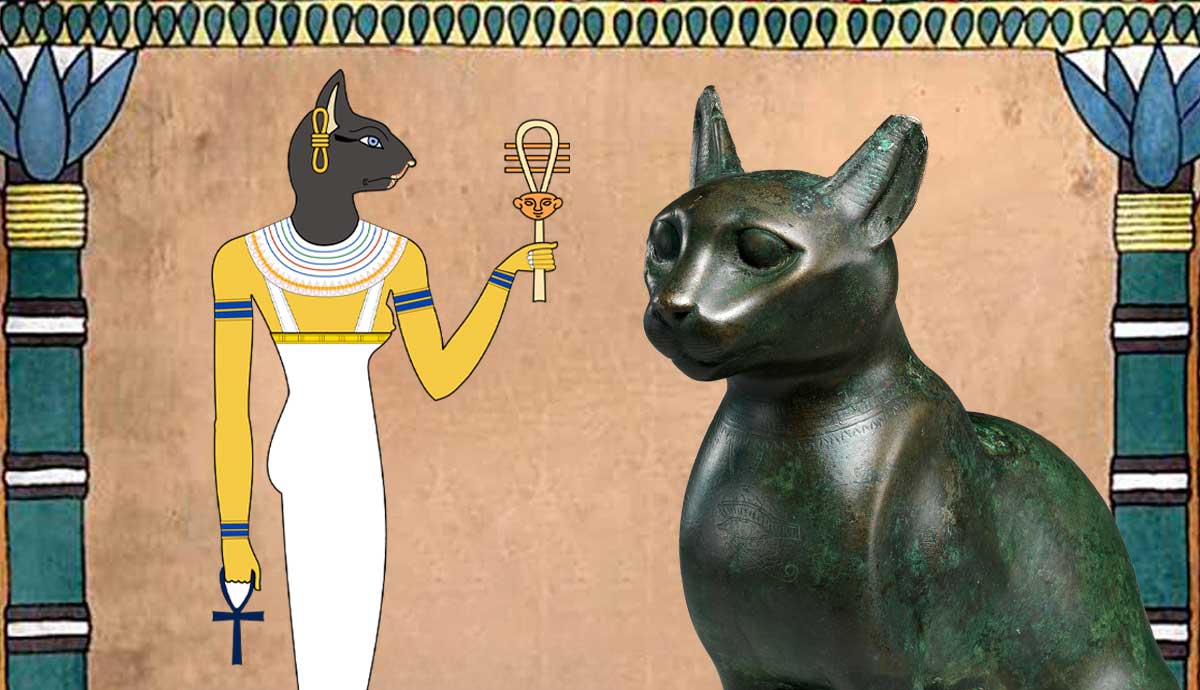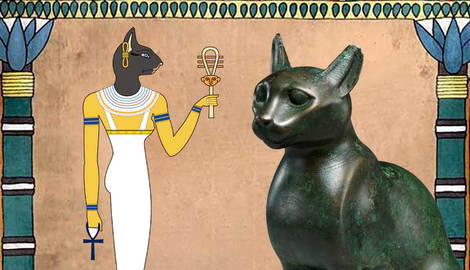
Also known as Bast, Bastet is one of the most important goddesses of ancient Egyptian mythology. She was most frequently represented as a long, slender woman with a feline head, carrying a sistrum and a breastplate. A goddess of great power, she had many attributes, including protection, pleasure, good health, and fertility. She is closely associated with the lioness goddess Sekhmet, and the two were even variations of the same goddess in different parts of early Egypt. Her many alternate epithets include the Lady of the East, Goddess of the Rising Sun, and the Sacred and All-Seeing Eye. Here are four fascinating facts about the feline goddess.
1. Bastet Was an Egyptian Cat Goddess

In the later centuries of ancient Egypt, Bastet was primarily represented as a half-human, half-cat creature in ancient Egyptian art. Previously, she had been a lioness goddess with the head of a lioness, known in Lower Egypt as Bastet and in Upper Egypt as Sekhmet. Her close relationship with cats gave Bastet special status in Egyptian culture. Cats were highly regarded for their ability to protect citizens from rodents, snakes, and other pests. Through their highly effective pest control, cats warded off the spread of disease and kept vital crops safe. Thus, Bastet shared many of these attributes with cats and became known as a great protector who kept humans and gods safe from evil predators. Within the heavenly realms, Bastet appeared as her human-cat hybrid, but while on Earth, she took the form of a cat.
2. Bastet Was the Daughter of Ra

Bastet, goddess of cats, was descended from the most significant family in ancient Egyptian religion. The Daughter of Ra, the god of life and creation, Bastet was by his side day and night. Egyptians believed she would ride through the sky each day with Ra, protecting him as his boat pulled the sun through the sky. At night, she turned into a cat to protect the sun god Ra from the deadly serpent Apep. In later Egyptian mythology, Bastet became known as the calmer sister of Sekhmet. She married Ptah and became the mother goddess to Mihos.
3. Bastet Was a Goddess of Protection, Pleasure, Fertility, and More

Bastet was worshipped as a deity throughout much of ancient Egypt’s evolution, most frequently in Lower Egypt, even if her form and power changed over the years. She was an Egyptian goddess with many associated attributes, including protection, pleasure, fertility, and good health. In many parts of Egypt, Bastet also became known as the goddess of the moon and was thought to be both the eye of the moon and the eye of Ra. Many Egyptians saw her feline attributes as all-powerful, with the ability to protect their homes from evil spirits and disease, much in the way cats could ward off vermin. Some Egyptians believed she had a particular benign form of power that could protect royalty, and her name was found in the valley temple of King Khafre in Giza.

Throughout the course of ancient Egyptian history, festivals and temples were erected in Bastet’s honor, and she even had her own cult in the northeast delta of the Nile. Evidence suggests some select groups continue to worship her today.
4. Bastet Was Also Known as Sekhmet

Somewhat confusingly, both the Egyptian goddesses Bastet and Sekhmet share many similarities and overlaps. In Lower Egypt, Bastet was worshipped throughout the evolution of Egyptian civilization. Her earliest form was that of a woman with a lion’s head rather than a cat. This made her remarkably similar to the goddess of Upper Egypt, called Sekhmet, who was also half woman, half lion. The pair shared similar attributes, both being the daughter of Ra, a feline, and female defenders of the innocent against forces of evil. In early mythology, both goddesses were vengeful and bloodthirsty, but over time Bastet became softer as her role shifted into that of a helper and friend. Both goddesses evolved from variations on Mafdet, the first feline deity to appear in Egyptian mythology, whose greatest attribute was that of protection.
When Lower and Upper Egypt merged, that’s when things became a little more complicated. Egyptians kept the two gods separate. The goddess Sekhmet became known as a goddess of war, retaining her leonine head, while Bastet became a cat goddess who was more peaceful and benevolent in nature.
5. Cats Were Mummified in Honor of Bastet

One of Bastet’s main cult centers was at Bubastis, and millions of mummified cats have been found there as votive offerings to the goddess. While this shows the great reverence that the Egyptians had for cats by giving them the same treatment as human remains, it was a harsh reality, with domestic cats often killed so that their human could be accompanied into the next life by a cat mummy. Various other animals were also mummified, but cats are by far the most common mummified animals.
Cat mummies also had a questionable afterlife. When Egyptomania hit Europe in the 19th century, cat mummies were not only bought as curiosities but also ground up and used for medicinal purposes and even as plant fertilizer.










